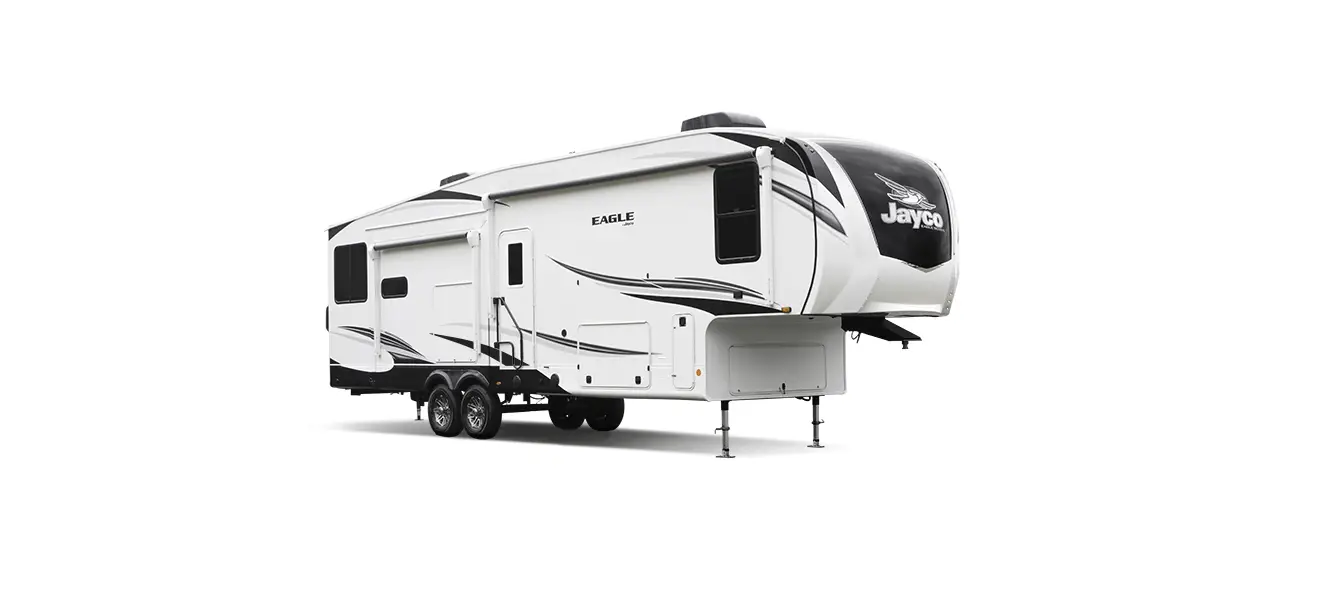Jayco Eagle Fifth Wheels 2023 Cargo Carrying Accessory User Manual
Cargo Carrying Accessory Receiver
Warning
Receiver is for cargo-carrying accessories ONLY. DO NOT tow any trailer or other vehicle. The load Limit for this receiver is 300 lbs. maximum. Use for towing or exceeding the load limit will void the warranty. Failure to follow the instructions can cause the carrier to collapse or items to fall which could cause an accident resulting in death or serious injury.
Rear Bumper
Caution
Do not add items to the recreation vehicle’s rear bumper. Add-on items will eventually damage your bumper. Damage caused by such aftermarket equipment installation or improper loading voids the Towable Limited Warranty.
The rear bumper of your RV is not designed to carry cargo. Items that extend beyond the bumper OR weigh over 100 lbs. (45kg) will place undue strain on the bumper. The 100 lb. bumper capacity includes the weight of the spare tire (if so equipped).
NOTE:
Some items may fall within the given weight range, (IE: bike racks) however, they can still cause damage. In addition, extra weight behind the axle may reduce the hitch weight which can adversely affect handling.
Fifth Wheel Pin Box (customer supplied).
Hitch selection affects the towing and handling characteristics of your recreation vehicle. There are many kinds of hitches available and assuring that you have the correct hitch in-stalled is critical to a safe towing.
Ask your dealer about the proper class and type of hitch you need to purchase for your individual tow vehicle/RV combination. A fifth wheel requires a pin box hitch bolted directly to the floor of the truck box through the frame.
The hitch class rating based on the capacity that hitch has for towing and a weight classification. The weight classification is determined from the hitch’s weight carrying capacity (the pin box weight on a fifth wheel). Before selecting a hitch, you must know your GVWR and pin box rating. The rating of the hitch package purchased should be equal to or greater than the RV’s GVWR and the pin box rating.
Caution
Using an oversized or undersized hitch can cause damage to the RV frame. We (as your RV manufacturer) cannot be responsible for the tow vehicle suspension system. The final ball height after the tow vehicle/fifth wheel combination is completely hooked up is a factor that must be considered. To avoid over-loading your trailer axles and minimize possible handling difficulties, your trailer should be level when hooked to your tow vehicle. Do not overload your tow vehicle.
Equipment that sometimes gives autos, trucks and sport utility vehicles a softer ride can accentuate swaying when pulling a RV; conversely, suspension that is too stiff will increase vibration, bounce and accelerate wear of your tow vehicle and RV combination. Your recreation vehicle manufacturer cannot be responsible for the suspension system of any tow vehicle. There are a variety of tow vehicle suspension systems available that will affect the pin box height, stability, and levelness of a hooked-up RV. Make sure your dealer is aware of the tow vehicle you are using so a compatible hookup is achieved.
Fifth Wheel Pin Box
The fifth wheel factory-installed pin box is not interchangeable. Maintain the proper pin box weight on the hitch.
Fifth Wheel Pin Box Height
There is no recommended hitch height for fifth wheels; usually, the fifth wheel pin box is adjustable for variance in trucks and truck suspension systems. Adjust the hitch assembly so the tow vehicle and the fifth wheel are essentially levels. A high hitch will transfer weight behind the axles and cause the vehicle to fishtail. A low hitch will transfer additional weight to the hitch. Refer to the hitch manufacturer’s instructions to adjust the weight-distributing hitch to the proper height. If you have additional questions, consult with your dealer. Make certain your Dealer is aware of the tow vehicle you are using so a compatible hookup is achieved.
Fifth Wheel Hitching Procedure
The following procedure will help to assist you in securely hooking up your recreation vehicle to your tow vehicle.
- Make sure the trailer wheels are blocked.
- Make sure the hitch lever is in its open or “cocked” position unless it has been designed to open automatically. Adjust the fifth-wheel travel trailer pin to the proper height. Lower the tailgate, if applicable.
- Back the truck so the hitch encircles the fifth-wheel/travel trailer pin.
- A gentle contact of the hitch saddle against the pin will cause the mechanism to close.
- Secure the hitch lever as specified by the manufacturer.
- Put the truck in drive (DO NOT press on the accelerator) and ‘bump’ the hitch to make sure it is locked.
- Be sure to raise the fifth-wheel landing gear all the way up.
- Attach the breakaway switch cable to the tow vehicle.
- Plug the wire harness/connector plug from the tow vehicle to the fifth wheel.
- Remove the wheel chocks from the trailer wheels.
Fifth-wheel landing gear can be operated manually. The fifth wheel landing gear must be fully retracted before moving or towing the RV to prevent damage.
Warning
DO NOT USE THE FIFTH-WHEEL LANDING GEAR TO SUPPORT THE TOW VEHICLE WEIGHT. The fifth-wheel landing gear is designed to bear the front-loaded weight of the RV only.
[amalinkspro_table id=”32452″ new-window=”on” nofollow=”on” addtocart=”off” /]
Reference Links
View Full User Guide: Jayco Eagle Fifth Wheels 2023 User Manual
Download Manuals: https://www.jayco.com/manuals


